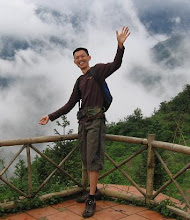Finally set up a blog.... well, better late than never. I'm not the "talkative" or OUTSPOKEN type, so I haven't the faintest idea in which direction this blog will veer to. So blogging will also be a journey for me ....hmm.., something like a 'walkablog' ,... 'walkablog' & 'walkabout'..... get it ??
Cheers,
Digger Lim
Cheers,
Digger Lim
*********** DRAGON OVER THE RED RIVER *************************
My recent trip saw our group crossing from Vietnam into China at the Lao Cai / Hekou border (Hekou being in Yunnan, China). We travelled on a road (which at some parts did not resemble a road at all) along the Red River ("Hong He" in Mandarin) in a north-westerly direction until we turn off to climb up to the rice terraces of Yuanyang.
The Red River flows from China (starting somewhere south of Dali, Yunnan) into Vietnam via the Lao Cai/Hekou border. It passes by Hanoi and then ends up in the Gulf of Tonkin. I realised that the first time I got close to the Red River was when I crossed it in May 2007 by walking on the Long Bien Bridge in Hanoi. Actually, any tourist who had been to Hanoi would have crossed the Red River, either in their tour bus (across Chuong Duong Bridge) enroute to Halong Bay or in their soft sleeper train cabin (across Long Bien Bridge) as they got ready to call it a night and looked forward to touring Sapa the next morning.
To reach Long Bien Bridge from the Old Quarter, head east until reaching the main road, Tran Quang Khai. Then proceed north along the main road until you see an overhead railway line spanning across the road. This railway line will lead you eastwards to the Long Bien Bridge, so cross the road using the pedestrian bridge nearby. From here you will be able to see the bridge.
The bridge was built in 1903 when Vietnam was under French colonial rule and named Paul Doumer Bridge, after the then French Governor General and future French President. After the French left in 1954, it was renamed Long Bien Bridge, "Long" meaning Dragon and "Bien" being the name of an old village near the river. Indeed sections of the steel cantilever bridge did look like the spine and scales of a dragon. Designed by Gustave Eiffel, it is also nicknamed 'the sleeping Eiffel Tower of Hanoi'.
The bridge has some of its posts anchored to an island in the middle of the Red River. This island provides for a refreshing getaway from the noise and chaos of Hanoi as you wander around the rows of rice, corn and vegetables. Southwards, you can see another bridge, the Chuong Duong Bridge which carries vehicular traffic. Long Bien Bridge is only for trains, motorcycles, bicycles and the pedestrian. From the bridge, you see a perspective of Hanoi from the outside looking in and enjoy the bliss of being away from the perpetual chaos and motion that is Hanoi.
This Dragon lost many of its "scales" during the Vietnam war (or American war as the Vietnamese call it). The bridge was a repeated target of American air attacks because of its strategic value as the only bridge linking Hanoi to Haiphong, North Vietnam's main port. In spite of the repeated attacks, the tenacity of the North Vietnamese repair teams kept the bridge in service until May 1972, when precision laser-guided bombs kept it out of use for a year. Though half of its original sections were lost and replaced with simple spans, the bridge remains very much an integral feature that defines Hanoi.











